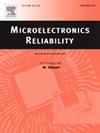Degradation modeling of InGaAs/InP avalanche photodiodes using calibrated technology computer-aided design
IF 1.6
4区 工程技术
Q3 ENGINEERING, ELECTRICAL & ELECTRONIC
引用次数: 0
Abstract
In this study, the degradation models of InGaAs/InP avalanche photodiodes (APDs) are proposed based on accelerated life testing (ALT) using technology computer-aided design (TCAD). Degradation modes identified by ALT are categorized into three types: (1) dark current (ID) increase, (2) breakdown voltage (VBR) reduction, and (3) the combination of (1) and (2). Two possible degradation mechanisms are suggested based on TCAD simulation: surface degradation for increasing ID and Zn penetration for decreasing VBR. After the initial I-V calibration using TCAD simulations, key degradation parameters were calibrated with ALT results to model the degraded characteristics of the APDs. As a result, an increase in the surface trap density of states at the SiNx/InP interface (Nint) and the fixed charge at the SiNx/InP interface (Qint) leads to an increase in ID at the InP/SiNx surface. In addition, a doping region was added with a gaussian function profile to model Zn penetration. An increase in the degradation parameter (α) within the gaussian equation leads to a decrease in VBR. The degradation models are investigated to evaluate changes in the structural and material properties over ALT time and performance of APDs. This study contributes to the understanding of degradation processes in InGaAs/InP APDs and also provides valuable insights into the analysis of device characteristics through similar reliability tests without the need for destructive or chemical analysis.
求助全文
约1分钟内获得全文
求助全文
来源期刊

Microelectronics Reliability
工程技术-工程:电子与电气
CiteScore
3.30
自引率
12.50%
发文量
342
审稿时长
68 days
期刊介绍:
Microelectronics Reliability, is dedicated to disseminating the latest research results and related information on the reliability of microelectronic devices, circuits and systems, from materials, process and manufacturing, to design, testing and operation. The coverage of the journal includes the following topics: measurement, understanding and analysis; evaluation and prediction; modelling and simulation; methodologies and mitigation. Papers which combine reliability with other important areas of microelectronics engineering, such as design, fabrication, integration, testing, and field operation will also be welcome, and practical papers reporting case studies in the field and specific application domains are particularly encouraged.
Most accepted papers will be published as Research Papers, describing significant advances and completed work. Papers reviewing important developing topics of general interest may be accepted for publication as Review Papers. Urgent communications of a more preliminary nature and short reports on completed practical work of current interest may be considered for publication as Research Notes. All contributions are subject to peer review by leading experts in the field.
 求助内容:
求助内容: 应助结果提醒方式:
应助结果提醒方式:


